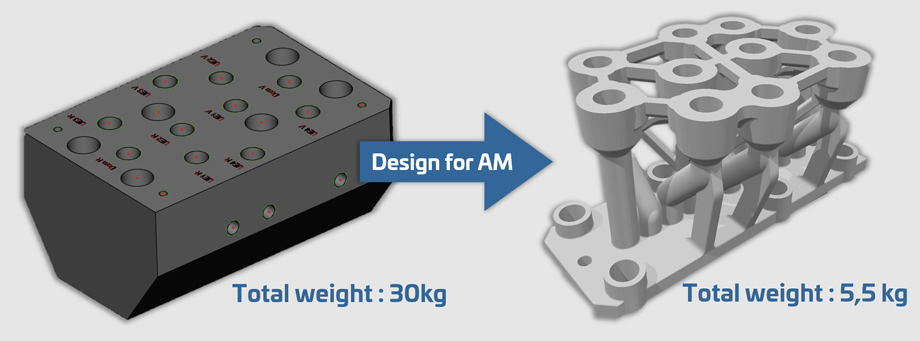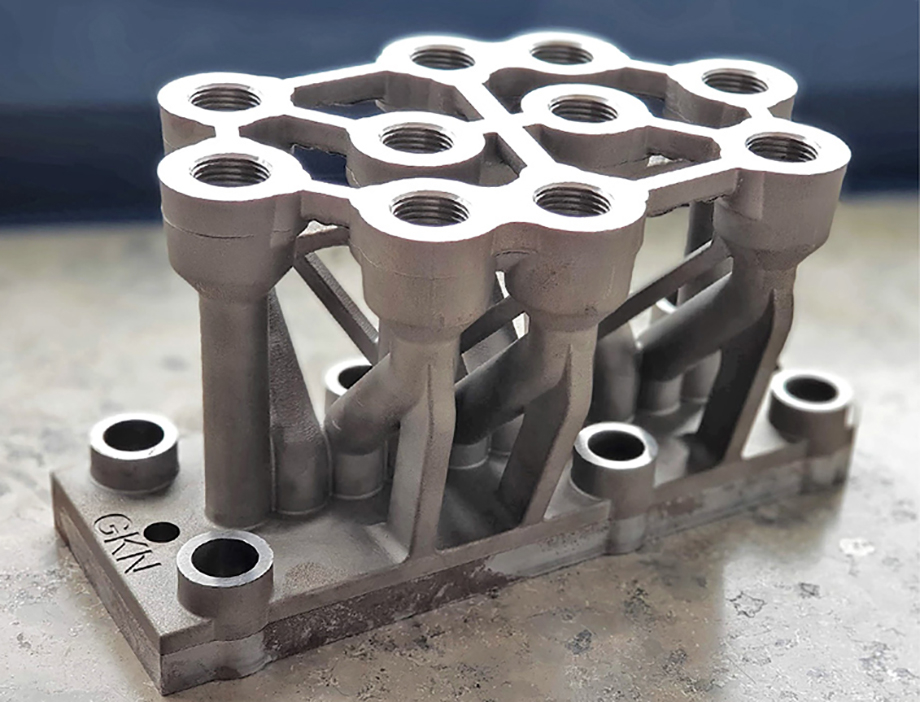GKN Additive has 3D printed a hydraulic adapter block which was redesigned to weigh 80% less than its traditionally manufactured counterpart. The UK-based technology conglomerate employed Design for Additive Manufacturing (DfAM) principles to reduce material use, resulting in a lower weight and cost while also improving functionality.

Traditionally manufactured hydraulic blocks
Hydraulic blocks tend to have a compact, blocky design with a set of internal channels drilled and milled into them. The internal channels control oil distribution in hydraulic systems, enabling operators to control heavy-duty machinery such as the arms of a crane or excavator. Firstly, holes are drilled from above and below. The vertical holes are then connected by horizontal channels and the threads are cut into them. To prevent oil leakage from the open horizontal channels, they are plugged with grub screws and sealed off.
The machining of these adapter blocks is extremely inefficient – both in terms of costs and functionality. The drilled and milled edges create sharp burrs that are difficult to reach in post-processing. These can sometimes break off during operation and cause system failure. Additionally, the sharp corner connection points generate turbulent flow, resulting in energy inefficiencies. Dirt reservoirs can accumulate in unused horizontal channels, reducing the operational life of the hydraulic system.
Redesigning the hydraulic block
GKN’s DfAM redesign utilized one of AM’s key advantages: complete design freedom. The project yielded an 80% weight reduction from 30kg down to 5.5kg, without sacrificing any of the functionality. The new design discarded much of the excess unnecessary material and ensured there were no bore overlaps within the part. The unused horizontal channels were omitted altogether so dirt had nowhere to accumulate. Sharp internal corners were replaced by smooth pipelines, which resulted in a significant reduction in turbulent flow in the system.
Furthermore, if any modifications were to be made to the design, the AM process would allow for this with ease. Rapid design iterations can be made on CAD software, as opposed to producing completely new tooling to change the location of the bore holes.

DfAM principles are useful in all verticals of industry, not just production tooling or heavy machinery. ADDIT·ION, a DfAM-centric service provider in Barcelona, has previously fabricated a 3D printed snowboard binding that secures athletes’ footwear to the board. The binding was geometrically optimized for weight and stress distribution to give the user a competitive edge. Last year, we also saw Vertico, a Netherlands-based concrete printing company, 3D print a functionally optimized and material-efficient footbridge. The team cut material use by 60% when compared to a traditionally manufactured bridge with its concrete 3D printing technology.
The nominations for the 2020 3D Printing Industry Awards are now open. Who do you think should make the shortlists for this year’s show? Have your say now.
Subscribe to the 3D Printing Industry newsletter for the latest news in additive manufacturing. You can also stay connected by following us on Twitter and liking us on Facebook.
Looking for a career in additive manufacturing? Visit 3D Printing Jobs for a selection of roles in the industry.
Featured image shows the hydraulic block redesigned for AM. Photo via GKN.



